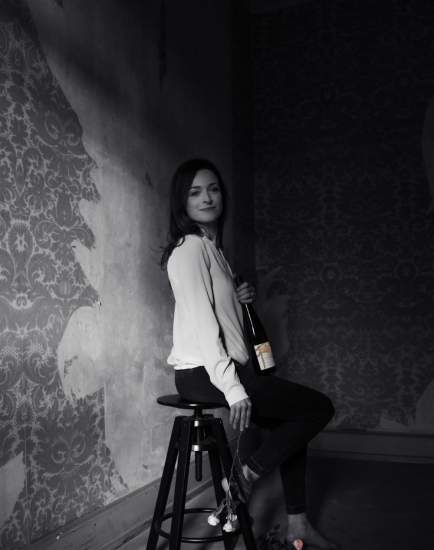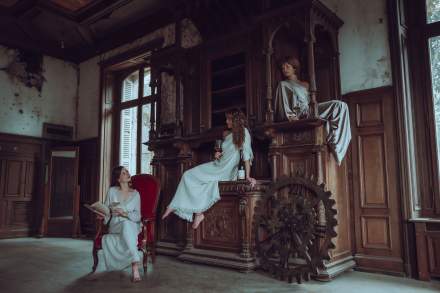Discover our terroirs

Rosenberg (5,81 ha)
Mountain of roses
On 18 July 2023, we set off on a visit that had been put off several times, the hot weather of the last few days having dissuaded us from any outings.
Maxime's 2CV struggled a bit climbing the first few metres of the Rosenberg hillside, but then overcame all the obstacles presented by the wonderfully varied Rosenberg landscape. Our first stop, at the bottom of this enormous hill, put us in a contemplative mood. You feel like you are being welcomed by an old friend who has made the place feel warm and cosy just for your benefit.
As you gaze up over the woody branches, you can see the 5 châteaux standing proud, towering over a verdant countryside of vine rows, carpets of vegetation and hedgerows planted in a patchwork of soils, the diversity of which, in such a small area, is impressive.
We continued our outing, pottering up and down the hill alongside the different vineyard plots. As we chat about the Rosenberg terroir, the image of a loving and supportive parent forms in our minds. The Rosenberg plots represent the creation of the Domaine, the union of the Barmès and Buecher families through the marriage of François and Geneviève. Together they created a fresco on this hill when they combined the vineyards planted by their forebears. Paradoxically, this Terroir, which represents a land of benevolence, is not a place Maxime visits often, as he has total confidence in it and this loyalty is borne out throughout the wines’ creation and ageing process.
Kneeling on the ground, we just have to scratch at the soil to see its impressive geological variety and its ability to retain moisture despite the heat of the last few days. Maxime explains that the Rosenberg soils are easy to work, good-natured and highly nuanced, just like the wines they create: complex and generous with a remarkable tension and lovely bitters.
After a good two hours spent exploring Rosenberg, we return to the Domaine. No need to talk any more, everything has been experienced and felt. We take our leave of this loving parent, knowing she will always be there for us, ready to lend us a helping hand.


Leimental (0,24 ha)
Valley of clay
This is a garden-sized plot of vines on almost flat land that seems to hang suspended in the middle of the Rosenberg hill. Its distinctively shaped pebbles, which are often flat too, come from the deep limestone strata...
The roots of our Riesling, which has been planted in Leimental for over 40 years, dig down deep between these strata, in a soil that is so rich in clay that when it's wet, you can knead it and shape it with your fingers. Once dry, it sets like a stone.
Like a kitchen garden, this plot requires bespoke work and, in return, offers us some of its finest grapes. We have developed a close, almost family-like attachment to this terroir, which has seen the birth of the great cuvées named after our children, and whose rows were once planted with vegetables grown by our grandmothers Madeleine and Denise.
Leimental gives us nothing but pleasant surprises! It has a disconcerting ability to produce intensely ripe Rieslings. It is a terroir that demands very special attention.
If you want to produce a dry wine here, you need to keep a close eye on it because it has an astonishing ability to develop over-ripe grapes or a magnificent Botrytis. In fact, it is very often one of the first plots of Riesling to be harvested.
Like the roots of the vines burrowing deep down into the soil, the Leimental Riesling takes hold of and wraps itself around the palate. It then creates a broad but gentle brushstroke, painting a pastel canvas in our imagination.
The finish is slightly bitter, saline, long and nicely structured. With the Riesling Leimental, you have the sensation of being embraced in strong arms.
Like with all fine wines, time works wonders! There are not many bottles available to delight the palate of only a few lucky wine drinkers. Only 1,000 to 1,500 bottles are produced each year from this terroir, of which only Domaine Barmès-Buecher produces a cuvée.


Clos Sand (0,78 ha)
Sand
Getting to Clos Sand is something of a challenge! After a walk over the hillside overlooking Wettolsheim, you still have to persuade the awkward gate to open.
Then you enter a place like no other...
Suspended between heaven and earth, sheltered by a green acacia grove, the sun's caressing rays are softened by a gentle breeze cooled by the forest, which brings the foliage to life and sends shivers down the spine of the observer. Or perhaps it's just the magic of the place...
The Clos Sand wines draw their brilliance, salinity and shine from their granite soil, even down to the chiselled precision of the prisms sparkling in the rock. These wines are upright yet lithe, like a tree trunk that guides its branches towards the light, to reach the sun and reproduce its warmth.



Grand Cru Steingrubler
(0,90 ha)
Stone quarry
It's around 4 pm and the sun is casting its last rays behind the three châteaux and the surrounding forest. Autumn has well and truly set in, and over the past week, the vines have lost much of their foliage.
I take the time to pick a few Gewurztraminer, grapes that have certainly been overlooked or hidden by the denser foliage during the harvesting.
I sit down in our plot of Steingrubler Grand Cru Gewurztraminer in Wettolsheim. The sky is blue and the weather is fine.
I walk up the row to pay a visit to our old apple tree. An apple falls off when I shake a branch. It was the last one on the tree and I had the privilege of biting into it! This small green apple was delicious: tart and crunchy, just the way I like them.
Funnily enough, it reminded me a little of the wine derived from this plot, a crisp Gewurztraminer with a zesty, saline structure. When I look at my apple tree in the distance and the forest clad in its magnificent autumn colours, I truly believe that this unspoilt countryside has an influence on the wine.
The colour of the soil in the Steingrubler Grand Cru is of a fascinating complexity. The soil has been freshly turned by the plough. A closer look reveals a palette of beige (the limestone), white (the quartz) and burgundy red (the sandstone). The most fascinating stone here is the granite. In fact, this very old granite breaks and decomposes easily between the fingers. In the light, you can see the quartz crystals sparkling, with shades of crimson, black and grey. This volcanic rock is itself composed of a mosaic of minerals.
This plot of Steingrubler Grand Cru Gewurztraminer, planted by my grandfather Jules, is located in a complex terroir. Complex in the geological sense, but also in terms of its microclimate. These Gewurztraminers benefit from both the warmth of their southern exposure and the coolness created by the surrounding forest. Their potential is extraordinary, there’s no doubt about that. The growing methods, which are tailored to its needs, are a source of life and the Terroir expression of this Gewurztraminer. My personal experience of our previous vintages has told me a lot about the quality potential and the respect afforded to this great Terroir. Time weaves its delicate, precise and finely-crafted work into these wines.


Grand Cru Hengst (1,37 ha)
The Stallion
It's early November and I'm sitting at the bottom of the slope of our Hengst Grand Cru Riesling, an old vineyard planted by grandfather Buecher.
The temperature is very pleasant for the time of year. No doubt this plot's warm micro-climate has something to do with it. I spot two of my fellow winegrowers on their tractors fitted with ploughs also making the most of the warm weather of the late afternoon.
I wonder whether the Hengst marl isn't starting to get a bit too hard to plough... the soil looks a bit dry.
Right now, I'm standing with my back to the south and the village of Wettolsheim, with Colmar to the east. It's almost dark now as I have just spent some time chatting to another winegrower. To the north, at the top of the forest-covered hill, I spy Château du Hohlandsbourg, which has been illuminated. The view is beautiful, and the villages to the south are now also lit up.
Ploughed by horse last week, the furrow made by the ploughshare has dried out. I think that the environmental benefits of this return to using animals (a practice that had fallen out of fashion for a good long while) are positive for people, nature and the terroir.
There is silence all around me now, and I can hear the wildlife starting to stir in the nearby forest. I pick up a handful of earth, a mixture of clay and limestone that crunches under my fingers. Sitting on the ground, I feel the warmth radiating from the marl in the south-south-east facing soil of the Hengst Grand Cru, which helps to reinforce the density of the wine expressed by the rocks.
This is a soil that demands you listen to it... The wines from the Hengst Grand Cru coat the palate just as their soil coats the fingers. This terroir generally produces wines that are long-lived, full-bodied, generous and spicy, with a hint of an animal character in some cases. This is a terroir for fine red wine in particular!
It's getting very late, and I haven’t seen the time go by, lost as I was in meditation in this remarkable and very unusual place! I love coming here to reconnect with what's most important and with the presence of our ancestors.


Grand Cru Pfersigberg (0,25 ha)
Mountain of peaches
We’re off on a girls’ day out to Eguisheim, officially classified as one of the prettiest villages in France.
The aim of this outing is not to stroll through the village's old narrow streets, but to pay a visit to our Pfersigberg Grand Cru vineyard. We missed the turning to the narrow lane leading to the vineyard several times, no doubt distracted by the village's fun summery atmosphere.
Finally, paying closer attention to the directions that Maxime had given us, we headed down the acacia-lined lane leading to the bottom of the Pfersigberg Grand Cru embankment.
Evidently poorly shod to climb the steep and stony path that leads to the plot, we proceeded carefully trying not to get too close to the soil, even though we had come that day to appreciate all its qualities!
When we reach our destination, the contrast with the touristic hustle and bustle below is striking. Everything here is peaceful and the soundscape is mainly just the chirping of birds in the nearby trees. The view from here is a shimmering panorama in which the village houses gradually disperse into the countryside, giving way to fruit trees and rows of vines.
We come here with a great deal of love and affection…it is almost as if we were visiting a grandparent.
This plot of vines is steeped in our family’s winegrowing history and was inherited from our maternal grandmother. It has been planted 4 times. Some of the vines still date back to 1963, others to 1986, then 2006 and the latest to 2016, using grafts from our old Gewurztraminer vines from the Hengst Grand Cru.
This mix of ages no doubt contributes to the vineyard's originality and lovely complexity. Its roots dig deep into the thick, heavy soil, which has an excellent water retention capacity making the most of any excess water while reducing the water stress. The Pfersigberg Grand Cru Gewurztraminers have never disappointed us. Even when the grapes are botrytised, they are of high quality and noble. Given this exceptional ripening potential, our Pfersigberg Grand Cru Gewurztraminer usually produces a great demi-sec at the very least, and if the year allows it, a great sweet wine or Sélection de Grains Nobles. The sweetness is always smoothly incorporated into the wine.
This is a wine that everyone loves, it is a good-natured wine without extremes and without aggressiveness. Among our different Gewurztraminer terroir wines, it is the one that is the most restrained in its youth... but what a fine wine it becomes over time! The soil provides an excellent base for the wine, giving it good length and preserving its aromatic finesse over time.
After this interlude suspended between two worlds, we set off again. The little tourist train that winds its way along the path below towards the village gradually brings us back to civilisation. We take our leave of the gnarled vines with the feeling that we had arrived for an unannounced visit but were leaving with a sense of being firmly rooted in the family lineage, balanced on this small branch of the family tree but reassured by the solidity of its roots.

